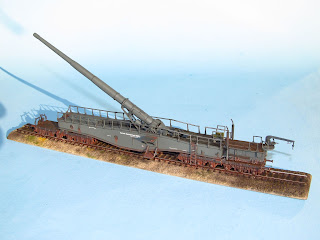Those of you who know me well know that I do not build models of Nazi scum weapons. However, I am a fan of very large guns and this subject caught my attention, so I built it despite my feelings that the plastic model industry far and away glorifies Naz scum.
It fired a 283 mm, quarter tonne projectile, a maximum of 150 km from the 25.5 m long barrel. In reality the range was closer to 80 km.
Germany built 25 of these somewhat inefficient railway guns. That said, they were probably the most effective railway gun of WWII and the Great Patriotic War, being relatively portable and much faster than towed artillery. Krupp began research in the 1920, and by 1934 was testing a smaller version. The final version was produced in 1936 despite the problem of the barrel splitting. This was solved by making the rifling grooves only 7 mm deep instead of 10 mm deep. This is the K5(E) Tiefzug 7 version, and was the standard form of this gun. The main gun and carriage weighs about 200 tonnes. If everything worked properly, the gunners could fire up to 15 rounds per hour (one every four minutes), but this rarely happened. Aiming required a curved track, or a switch, or a turntable, as the gun itself had only 1 degree of traverse.
Each battery consisted of two guns on three trains with four locomotives (one steam and one diesel) with a crew of 42 officers and men per gun. Then there were additional staff such as cooks, security teams, and railway personnel for the guns and three trains. The diesels were used to hide battlefield movement as the steam locomotives gave off too much smoke.
Two K5(E) guns (one battery) were sent to the siege of Sevastopol in late 1941-early 1942.
Note that the main carriage bears a large label stating "Deutsche Reichsbahn Berlin", or German State Railway (Berlin). These rail cars officially belonged to the railway - not to the army. Of course this was the same for the cattle cars used to transport jews to death camps, so that is the Nazi mentality for you. It is interesting that as the USSR withdrew most rolling stock during the Nazi invasion of the USSR, the Nazis had to use their own trains in Russia, but could not due to the size of the tracks. Deutsche Reichsbahn and the army had to lay over 16 000 km of German trackage to accommodate the Nazi army inside Russia, including the two K5(E) railway guns moved to Sevastopol, in roughly four months during the Nazi invasion named Operation Unternemen Barbarossa.
The model took three days to make, and is painted with Vallejo acrylics and powders. Painting and detailing the trackbed took two days.
 |
| Nazi Krupp K5(E) 283 mm heavy railway gun (eisenbahngeschütz) |
 |
| Nazi Krupp K5(E) 283 mm heavy railway gun (eisenbahngeschütz) |
 |
| This is the real gun in the rail yard on newly-laid German gauge tracks near Sevastopol, USSR, in 1942-1942 |
 |
| This is the real gun in the rail yard on newly-laid German gauge tracks near Sevastopol, USSR, in 1942-1942 |
 |
| Nazi Krupp K5(E) 283 mm heavy railway gun (eisenbahngeschütz) |
 |
| Nazi Krupp K5(E) 283 mm heavy railway gun (eisenbahngeschütz) |
 |
| Nazi Krupp K5(E) 283 mm heavy railway gun (eisenbahngeschütz) |
 |
| Nazi Krupp K5(E) 283 mm heavy railway gun (eisenbahngeschütz) |
 |
| Nazi Krupp K5(E) 283 mm heavy railway gun (eisenbahngeschütz) |
 |
| Nazi Krupp K5(E) 283 mm heavy railway gun (eisenbahngeschütz) |
 |
| Nazi Krupp K5(E) 283 mm heavy railway gun (eisenbahngeschütz) |
 |
| Nazi Krupp K5(E) 283 mm heavy railway gun (eisenbahngeschütz) |
 |
| Nazi Krupp K5(E) 283 mm heavy railway gun (eisenbahngeschütz) |
 |
| Nazi Krupp K5(E) 283 mm heavy railway gun (eisenbahngeschütz) |
 |
| Nazi Krupp K5(E) 283 mm heavy railway gun (eisenbahngeschütz) |
 |
| Nazi Krupp K5(E) 283 mm heavy railway gun (eisenbahngeschütz) |
 |
| Nazi Krupp K5(E) 283 mm heavy railway gun (eisenbahngeschütz) |

